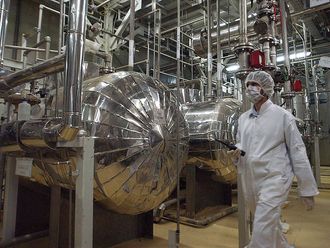_resources1_16a085166b2_medium.jpg)
Amman: A US-backed military offensive has stalled against Daesh’s last vestige in eastern Syria.
Booby traps, land mines and a militant counterstrike during a fierce sandstorm after the campaign began in September have knocked the coalition back on its heels.
And last week, the Syrian Democratic Forces, the Kurdish-led militia that is fighting Daesh with US help, suspended operations after Kurdish positions farther north were shelled by Turkey – not far from US advisers.
US diplomats and generals rushed to ease tensions with the Turks, who consider Kurdish fighters terrorists despite their partnership with the United States.
But the episode underscores the shifting nature of the fight against Daesh, a still-potent threat as it pivots from its battlefield losses in Iraq and Syria to directing guerrilla insurgencies in the Middle East and beyond.
“Although Daesh’s safe haven in Iraq and Syria has largely collapsed, its global enterprise of almost two dozen branches and networks, each numbering in the hundreds to thousands of members, remains robust,” Russell Travers, the acting head of the National Counterterrorism Centre, told senators in Washington last month.
Last week, Daesh claimed responsibility for an attack on a bus carrying Coptic Christians to a monastery in Egypt, which killed seven people and wounded 19 others. Dutch officials said in late September said they foiled a large, multisite terrorist Daesh attack there.
In Jordan, state intelligence officials said they had worked closely with the CIA to thwart more than a dozen terrorist plots in the past several months in the Middle East and Europe.
A classified US military programme in Jordan, called Operation Gallant Phoenix, is scooping up data collected in commando raids in Syria and Iraq and funneling it to law enforcement agencies in Europe and Southeast Asia, according to US military and intelligence officials who described details of the initiative on condition of anonymity because of its secretive nature.
In Afghanistan, Daesh’s local branch has conducted a spate of high-profile attacks against civilian and government targets in Kabul while carving out a sanctuary in the country’s east, Travers said. Other Daesh affiliates in Egypt’s Sinai Peninsula, Libya, Yemen and western Africa continue to mobilise fighters and execute attacks against local governments and group rivals, fomenting and leveraging instability in these already beleaguered areas.
“Daesh remains an adaptive and dangerous adversary and is already tailoring its strategy to sustain operations amid mounting losses,” he said.
To be sure, thousands of Daesh members - including senior leaders, veteran field commanders and foreign fighters - have been killed in US air strikes and partner actions. The extremist group now holds less than 1 per cent of the territory it seized in Iraq and Syria in 2014.
But Daesh has reverted to its insurgent roots - an atomised, clandestine network of cells with a decentralised chain of command, Western and Middle Eastern counterterrorism officials said.
The move follows plans that the extremist network drew up in the months before its main strongholds in Mosul, Iraq, and Raqqa, Syria, fell to coalition forces last year.
“We’ve expected that as the physical caliphate went away, the remnants of this would attempt to revive themselves and revive their networks, and take on these insurgent, guerrilla-like tactics,” Gen. Joseph L. Votel, the head of the military’s Central Command, said in an interview in Bahrain last week.
“We’re well prepared for that,” said Votel, who oversees the US military in the Middle East and Southwest Asia. “These organisations never go away in one fell swoop.”
The number of foreign terrorist fighters, once pouring into Iraq and Syria at about 1,500 a month, has dropped sharply. But Daesh still attracts about 100 new foreign fighters to the region each month, Gen. Joseph F. Dunford Jr., the chairman of the Joint Chiefs of Staff, told a meeting of military chiefs in October.
In Iraq, Daesh sleeper cells in recent months have carried out raids and ambushes against Iraqi security forces and civilians, particularly in Anbar, Kirkuk and Salahuddin provinces.
And as Daesh hunkers down in Syria, including in caves and fortified tunnels in Hajin and a few surrounding villages in the Euphrates River Valley, it wields a diminished but still formidable social media prowess to rally its followers on the ground and on the internet.
“It is displaying its wins on its official online channels, including the alleged capture of enemy fighters and the killing and wounding of many others,” said Laith Al Khouri, a senior director at Flashpoint, a business risk intelligence company in New York that assesses the global terrorist threat.
The fighting in Hajin and nearby villages, where militants hide amid some 60,000 residents, is some of the most intense since the coalition pushed Daesh out of Raqqa and Mosul, allied officials said.
The Kurdish-led Syrian Democratic Forces has lost 327 fighters since the beginning of the military operation in September, according to the Syrian Observatory for Human Rights, a group based in Britain that monitors the war through contacts on the ground.
Daesh “has been avoiding direct clashes with our forces, relying on targeting with artillery and heavy weapons the obvious routes our fighters are forced to take in order to advance,” said Mustafa Bali, a militia spokesman.












